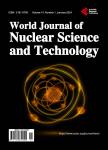Assessment of Exposure Due to Technologically Enhanced Natural Radioactivity in Various Samples of Moroccan Building Materials
Assessment of Exposure Due to Technologically Enhanced Natural Radioactivity in Various Samples of Moroccan Building Materials作者机构:Laboratory of Physics and Nuclear Techniques Atomic and Molecular Chouaib Doukkali University El Jadida Morocco Regional Center of the Trades of Education and Training El Jadida Morocco Ministère de l’Intérieur El Jadida Morocco Groupe RaMsEs Institut Pluridisciplinaire Hubert Curien (IPHC) Université de Strasbourg Strasbourg France
出 版 物:《World Journal of Nuclear Science and Technology》 (核科学与技术国际期刊(英文))
年 卷 期:2018年第8卷第4期
页 面:176-189页
学科分类:1002[医学-临床医学] 100214[医学-肿瘤学] 10[医学]
主 题:Building Materials Natural Radioactivity Radionuclide Radon Exhalation Rate Radium Equivalent Annual Effective Dose
摘 要:The aim of our present work is to measure the specific activities of the radionuclides 226Ra, 232Th, 40K and the exhalation rates in terms of area and mass of 222Rn in some samples of building materials commonly used in Morocco in order to evaluate the radiological risk caused by natural radioactivity. To this end, the analyses were carried out, using two nuclear techniques, namely high resolution gamma spectrometry and alpha dosimetry based on the use of LR115, on 50 samples collected from large commercial suppliers in Morocco. The results of these analyses show that the average specific activities of 226Ra, 232Th and 40K in these materials vary from 9 to 52 Bq/kg, 3 to 63 Bq/kg and 68 to 705 Bq/kg respectively. These activities remain within the permissible limits of 35 Bq/kg, 30 Bq/kg and 370 Bq/kg respectively, with the exception of a few samples of red brick, gray cement, ceramic and granite. The activity of the radium equivalent (Raeq), the internal (Hin) and external (Hex) hazard indices, the absorbed dose rate, the total annual effective dose , the excess lifetime cancer risk (ELCR) as well as volumic activities, exhalation rates in terms of area (ES) and mass (EM) are calculated for the samples analyzed in this work in order to assess the radiological risks resulting from the use of these materials in various construction activities. It seems that the values of these indices vary from 19 to 196 Bq/kg, 0.08 to 0.67, 0.05 to 0.53, 9 to 91 nGy/h, 0.05 to 0.56 mSv/y, 0.19 × 10−3 to 1.96 × 10−3, 72 to 350 Bq/m3, 56 to 273 mBq⋅m−2⋅h−1 and 3 to 15 mBq⋅kg−1⋅h−1 respectively. The lowest values are identified for gypsum, while the highest are attributed to granite. All of the obtained results of these indices respect the permissible limits except for the Raeq in some granite samples, the ELCR index in all samples except gypsum and the radon volumic activity in some gray cement samples, ceramic and granite. As a



